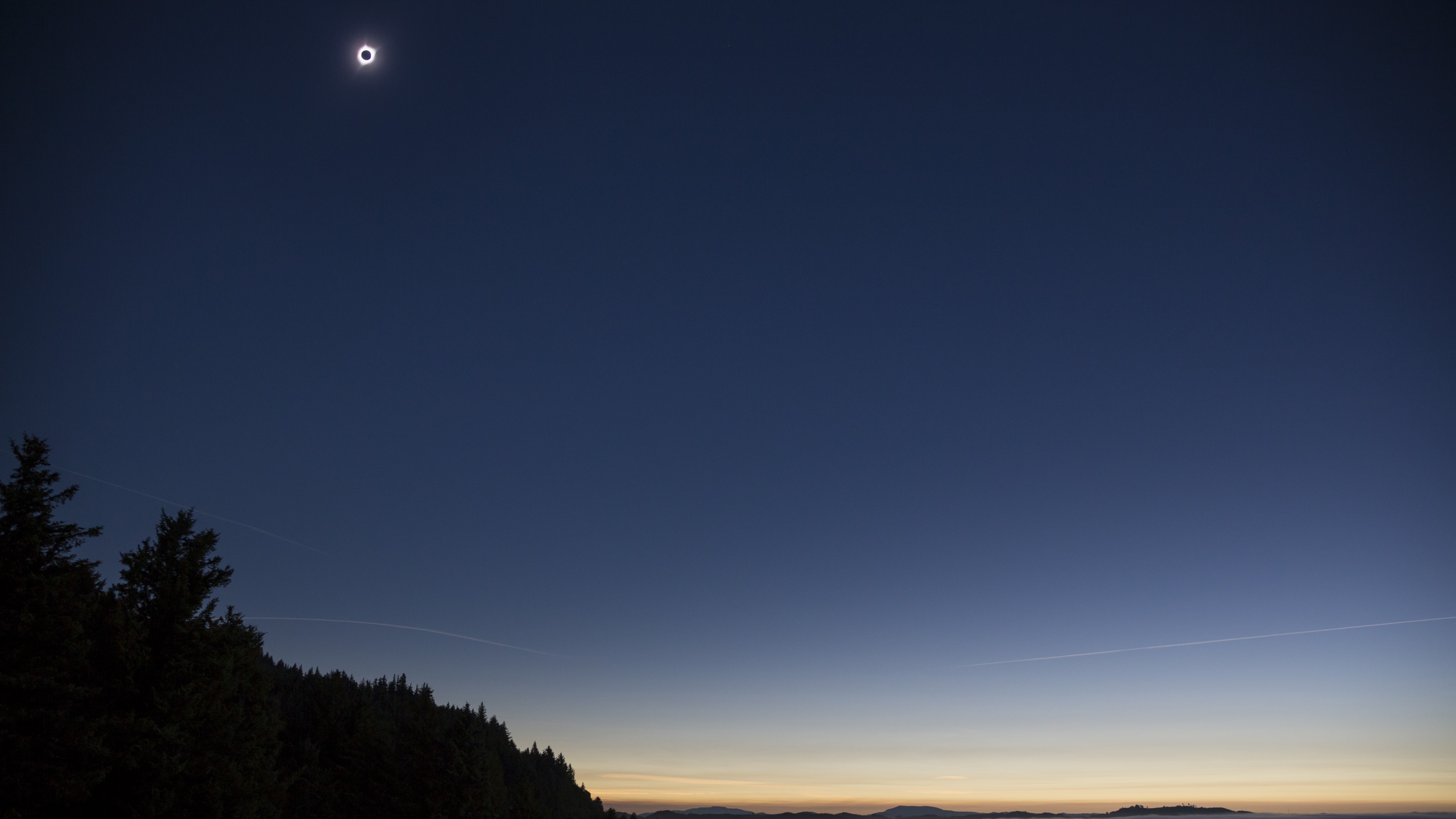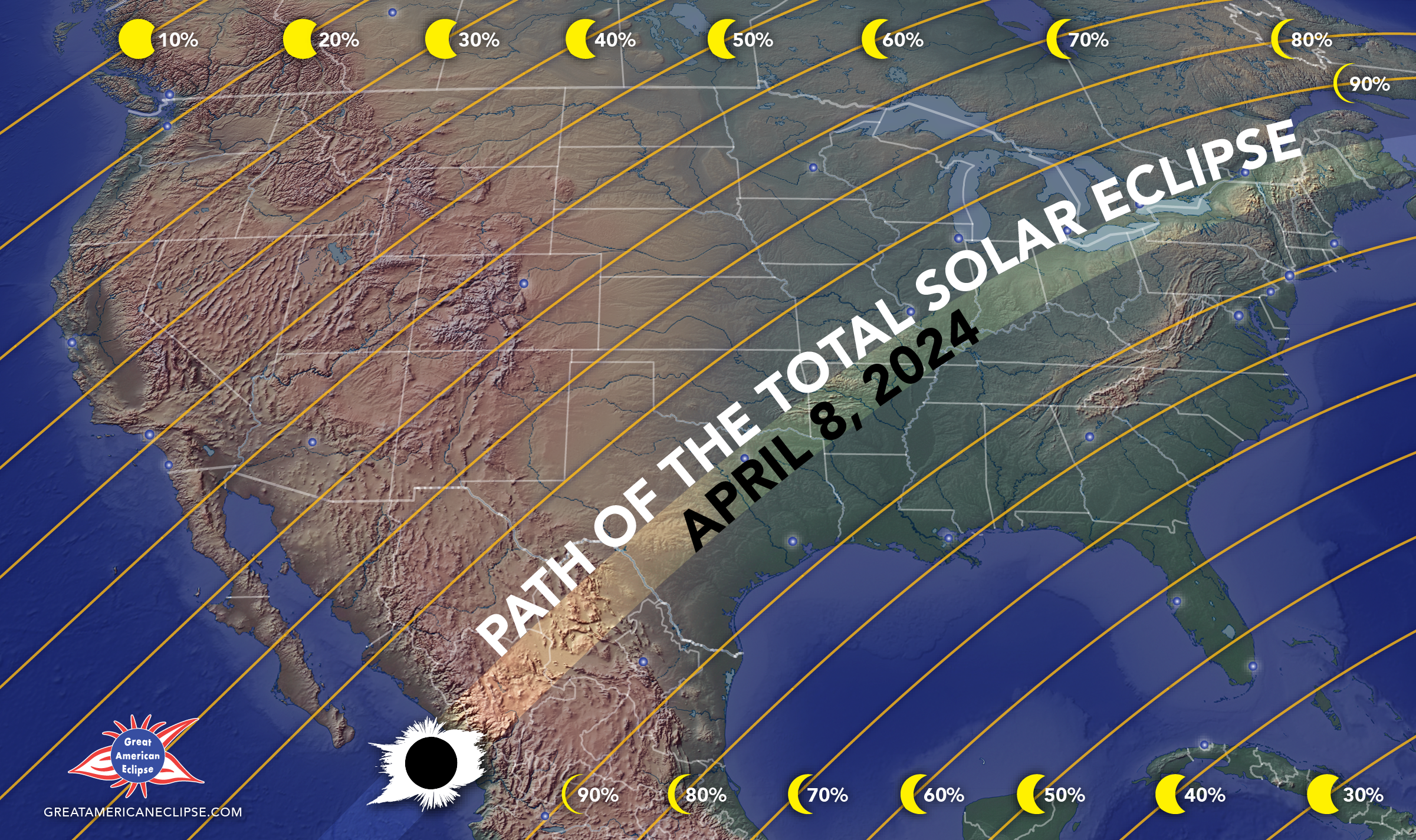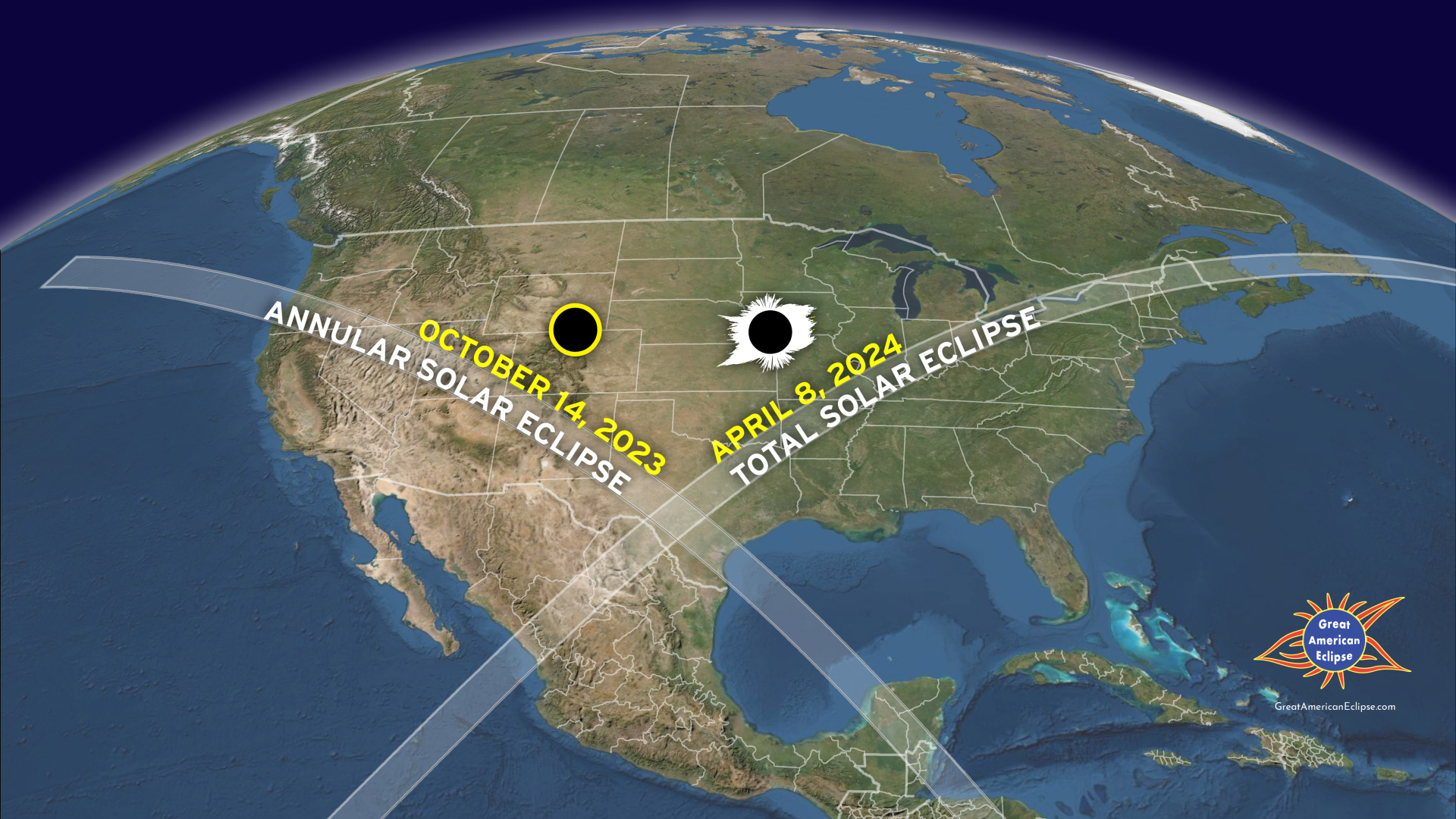10 things you probably didn't know about the 2024 total solar eclipse
What's 10,000 miles long, will take 100 minutes and will repeat in 2078?

- 1. Totality will occur on land for 100 minutes
- 2. It will be nothing like October's 'ring of fire' solar eclipse
- 3. Parts of 15 U.S. states will experience totality
- 4. Tennessee and Michigan get only a technical totality
- 5. A tiny village in Mexico will get the best view
- 6. It's part of a repeating event in North America
- 7. Seasons determine the path of totality
- 8. It's a 'city eclipse'
- 9. Alaska misses out on totality — but not for long
- 10. The U.K. will have the last view of the eclipse
On April 8, 2024, North America will experience the world's longest land-based total solar eclipse in over a decade.
The path of totality will cross parts of four states in Mexico, 15 U.S. states, and five Canadian provinces, allowing around 40 million people to witness the celestial spectacle.
You can watch the total solar eclipse live here on Space.com. And keep up with all the actions with our total solar eclipse 2024 live updates blog.
But how much do you know about it? From exactly how long the moon's central shadow will move across the planet to why the event will repeat for hundreds of years — and one day return to North America — here are ten facts that may surprise you.
Related: Why April's total Solar Eclipse will bring unique views of the sun's corona
1. Totality will occur on land for 100 minutes
After the moon's central shadow touches the Earth at sunrise in the Pacific Ocean close to Starbuck Island in Kiribati, it will take 3 hours and 16 minutes to cross the Earth before it departs at sunset in the Atlantic Ocean north of the Azores.
The path of totality will be about 10,000 miles (16,000 kilometers) long, less than half of which occurs on land. Totality will move across North America — Mexico, the U.S. and Canada — in 100 minutes, spending 68 minutes moving across parts of 15 U.S. states.
Breaking space news, the latest updates on rocket launches, skywatching events and more!
For those within the path of totality, it will bring the longest totality on land (4 minutes 28 seconds) since the total solar eclipse on July 11, 2010, in Easter Island/Rapa Nui.
2. It will be nothing like October's 'ring of fire' solar eclipse
If you saw the annular solar eclipse on October 14, 2023, through eclipse glasses, and you're considering giving this one a miss, think again. This is a total solar eclipse, where the moon will briefly cover the entire disk of the sun.
Only during this kind of solar eclipse can the sun's outer corona be seen with the naked eye—it's like seeing our star for the first time, floating in space, and it's guaranteed to leave you a gibbering wreck.
REMEMBER to NEVER look at the sun directly. To safely view this solar eclipse you must use solar filters. Only during the exact moment of totality, when the moon completely obscures the sun can you look with the naked eye. At all other times, precautions need to be taken. Observers will need to wear solar eclipse glasses, and cameras, telescopes and binoculars must have solar filters placed in front of their lenses.
Related: Best solar viewing kit 2024: Observe the April 8 solar eclipse
3. Parts of 15 U.S. states will experience totality
About 115 miles wide as it races across Earth's surface, the path of totality will cross parts of four states in Mexico (Sinaloa, Nayarit, Durango and Coahuila), 15 U.S. states (Texas, Oklahoma, Arkansas, Missouri, Illinois, Kentucky, Tennessee, Michigan, Indiana, Ohio, Pennsylvania, New York, Vermont, New Hampshire and Maine) and seven Canadian Provinces (Ontario, Quebec, New Brunswick, Prince Edward Island, Nova Scotia and Newfoundland). In the U.S., totality will begin in Texas at 1:27 pm CDT and end in Maine at 3:35 pm EDT.
Related: Where will the April 2024 total solar eclipse be visible from?
4. Tennessee and Michigan get only a technical totality
The path of totality touches a small corner of Tennessee and Michigan. In Tennessee, only the northwest corner is in the path, with a maximum of 2 minutes and 7 seconds at Kentucky Bend/New Madrid Bend. In Michigan, only the southeast corner is in the path, with 1 minute 20 seconds at the exclave of Lost Peninsula Marina.
5. A tiny village in Mexico will get the best view
Within any path of totality is a center point, a point of maximum eclipse, where a total solar eclipse will be experienced around midday with the sun and moon at their highest in the sky. It's here where the geometry of the sun, moon, and Earth line up precisely, meaning the slowest-moving shadow — and so the longest totality.
On April 8, that point is just 4 miles (6 kilometers) to the north of Nazas, population 3,600, in the Mexican state of Durango. From here, totality will last 4 minutes and 28 seconds.
6. It's part of a repeating event in North America
Solar eclipses come in families called Saros (Greek for repetition). Every 6,585.3 days, a shadow of the moon hits Earth of roughly the same proportions as the previous one. The only reason it doesn't occur in the same place is that .3 of a day (around 8 hours), which means Earth has rotated slightly.
The total solar eclipse on April 8 is part of Saros 139, which 6,585.3 days previously, on March 29, 2006, produced an almost identical totality for Africa and Asia. The next eclipse in Saros 139 after 2024 will occur on April 20, 2042, when totality is visible from Indonesia, Eastern Malaysia, Brunei and the Philippines.
However, every fourth repetition (54 years), a total solar eclipse occurs in roughly the same place, something called an exeligmos:
- March 7, 1970: Mexico, the U.S. (Florida, Georgia, South Carolina, North Carolina, Massachusetts) and Canada (Nova Scotia and Newfoundland)
- May 11, 2078: Mexico, the U.S. (Louisiana, Mississippi, Alabama, Florida, Georgia, South Carolina, North Carolina and Virginia)
7. Seasons determine the path of totality
Look at the central paths of the two solar eclipses that will strike North America within six months — the annular solar eclipse on October 14, 2023, and the total solar eclipse on April 8, 2024.
One shadow moves northwest-southeast, and the other moves southwest-northeast, but why? Though the position and distance of the moon have a huge effect on the eclipse, the differing orientation of the paths is down to Earth's titled axis, which is leaning different ways during both eclipses. In October (fall), the Earth moves downwards as it rotates, while in April (spring), it moves upwards.
8. It's a 'city eclipse'
About 40 million people live within the path of totality on April 8, around three-quarters of them in the U.S. Major cities inside the path include Mazatlan and Torreon in Mexico, San Antonio, Austin, Dallas-Fort Worth, Indianapolis, Little Rock, Cleveland, Buffalo and Rochester in the U.S. and Hamilton and Montreal in Canada. That accounts for about 10 million people. However, there are also many huge cities close to the path of totality, whose residents only have to drive very short distances to experience totality — something eclipse-chasers travel worldwide to experience. St Louis, Cincinnati, Toronto and Quebec are very close to the path, while the inhabitants of Houston, Chicago, Detroit, Boston, New York, Philadelphia, Baltimore, and Washington, D.C., are all within 200 miles of the path of totality.
9. Alaska misses out on totality — but not for long
Neither of the two non-contiguous U.S. states will see a total solar eclipse on April 8. Hawaii will see a 20% partial solar eclipse at sunrise. In comparison, only southeast Alaska west of Juneau — including Glacier Bay National Park and Preserve — will see up to a 5% partial solar eclipse mid-morning. However, Alaska will only have to wait until just after sunrise on March 30, 2033 — almost exactly 9 years later — before it sees a total solar eclipse. A maximum of 2 minutes and 37 seconds of totality will be experienced, with key observing locations within a 500-mile wide path of totality, including Utqiaġvik, Kotzebue, Nome and St Lawrence Island.
10. The U.K. will have the last view of the eclipse
Few will notice it, but this total solar eclipse for North America ceases to exist on the west coast of the U.K. A sunset commences on April 8, from the west coast of Wales, England, and Scotland, where it will be possible to see a tiny bite taken from the sun in the slightest of partial solar eclipses. A very low view of the horizon will be required — in practice, an ocean horizon — as well as clear skies.

Jamie is an experienced science, technology and travel journalist and stargazer who writes about exploring the night sky, solar and lunar eclipses, moon-gazing, astro-travel, astronomy and space exploration. He is the editor of WhenIsTheNextEclipse.com and author of A Stargazing Program For Beginners, and is a senior contributor at Forbes. His special skill is turning tech-babble into plain English.


